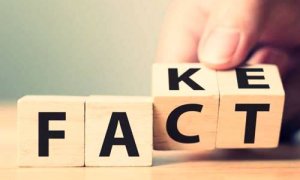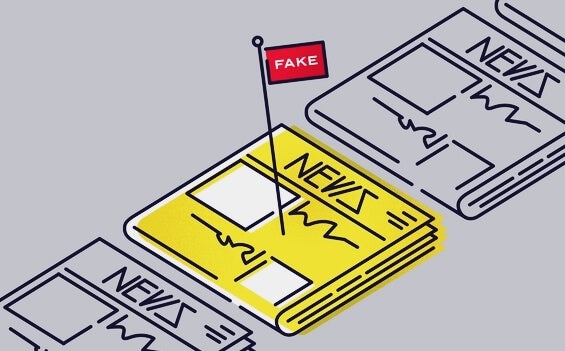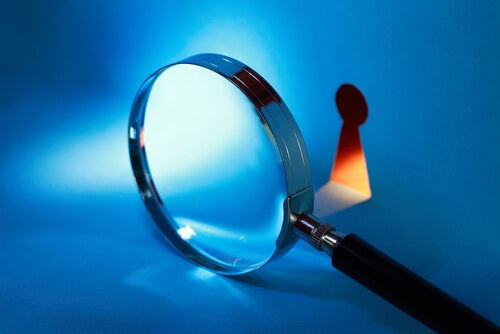Fake Scientific News: Detect it with These Six Steps

Fake scientific news, or the misinterpretation of certain data and the spread of such data, is another virus we’re facing. However, in these times of crisis, what we all need is certainty, evidence, and reassurance. Thus, we all need to take a critical view of the news we receive. This will help us navigate better through the inevitable waves of information that hit us daily.
This isn’t a trivial matter. Hoaxes and fake news about the coronavirus are circulating faster on social networks than authentic data from official and proven sources.
This has made many of us believe, in recent weeks, the news that the coronavirus is deactivated by drinking very hot drinks or that, with the arrival of summer heat, the virus won’t be able to survive and we’ll be free of infections.
To this fact, we can add another factor that’s no less problematic. Often, we find ourselves with “apparently scientific” studies which we believe because they come from some learned body or supposed university.
The rush to publish
However, there’s something we should all understand here. The rush to publish, and sometimes even corporation zeal, make some of these reports neither valid, sustainable, or representative.
An example of this is the constant news about alleged vaccines. People are attracted to these reports due to their emotional needs. They crave solutions and any sort of information that encourages them and gives them hope.
We share things without comparing them, we take them to be true without applying the filter of critical thinking. As a result, and almost without even realizing it, we fall once again into the corrosive trap of fake news.

How to detect fake scientific news
Noam Chomsky points out that the rise of fake news generates disillusionment. We end up encouraging a certain disaffection towards institutional structures and this can be a danger in the current situation. We may end up mistrusting even official and rigorous scientific publications. The latter would be a very worrying development.
A few days ago, scientists Dietram A. Scheufele and Nicole M. Krause of the University of Wisconsin-Madison conducted a study. In it, they said that people need to be more scientifically informed.
And something like this can only happen when we know how to detect the false from the true, and what’s reliable from what’s clearly inconsistent.
We must train our eyes to detect bias. We must be motivated to go beyond a grandiloquent headline that seeks, above all, the desired clickbait.
Likewise, we must train ourselves to have a mental and emotional filter that will help us to separate science from pseudoscience. Here, we can cite information that tells us that certain food supplements will protect us against the coronavirus or that this disease originated in 5G phone networks.
Yes, we aren’t all scientists. However, trying to spot fake scientific news forces us to take a rigorous approach. Doing so is a matter of responsibility and necessity at this time. These strategies can help us to filter out what’s valid from what’s inconsistent, dubious, and clearly false.

1. Who’s giving you the information? Strive to find the source
When you open your social networks and encounter that vast ocean of news, two things happen. The first is that the media compete with each other to provide us with the most sensational news. The second is that we keep the headline and share it. That’s a mistake.
To detect fake scientific news, you must know the source. Sometimes, journalists themselves interpret a study completely wrongly. Or, moreover, they may tell us that “a vaccine is already available” when that research is still in the early stages of experimentation.
Thus, always be aware that all information can be interpreted in different ways, depending on the person. Go to the original study, to the original news, and analyze it calmly.
2. Be wary of sensationalist headlines
Mistrusting sensationalist headlines, those that sometimes tug at your emotions, is vital when trying to sift out the truth from the lies.
The media that use these headlines are only looking for clickbait. They only want us to share the news and aren’t concerned that you might be spreading a hoax. Remember that, sometimes, behind the fake news, there are partisan interests.
3. The more details and the more objective, the better
Timothy Caulfield, a research professor in health law and policy at the University of Alberta, pointed out something interesting in one of his articles. He said that people are more likely to look at headlines that convey either something very negative or something very positive and almost miraculous.
To detect false news about science, you shouldn’t get carried away with emotionality. Rigorous, reliable, and valid studies don’t look to appeal to your emotions. They’re concise, objective, and provide multiple data and details.
Once again, remember the need to go to the sources in any report that’s informing you about something. All news can be interpreted in different ways, and you must go to the original references.

4. Apply a scientific approach: when you read a news item, look for links and references
We pointed this out earlier. When you click and read a news item, be demanding and smart. Look for links, sources, references, and data that point to original sources, even if they’re in other languages.
5. Who else is publishing the news?
Another strategy for detecting fake news is to know how many media outlets are publishing that information. If you transfer that data to the search engine and discover that nobody else has published anything about it, this clearly suggests that it may be fake news.
6. To detect false news about science, you need time, critical vision, and effort
If there’s one thing that defines the society we live in, it’s immediacy. When a sensational news item is published, it can take only a few minutes to go viral.
However, not even 20% of those who have shared this information have bothered to read it, compare it, and assess whether it’s reliable or not.
You must be aware of one crucial aspect. This is something that’s more important than ever. To detect fake news about science, you have to apply effort, a critical eye, and time. It isn’t enough just to read the headline. It isn’t enough to blindly believe the opinion of a journalist.
Broaden your vision
Therefore, broaden your vision, become a Sherlock Holmes of the information you receive. And, above all, be demanding with yourself.
We all need to be respected regarding the news they send us. We need truthful information and this means that we must be active, critical, and responsible. Avoid sharing information that isn’t reliable and that hasn’t been proven.
Fake scientific news, or the misinterpretation of certain data and the spread of such data, is another virus we’re facing. However, in these times of crisis, what we all need is certainty, evidence, and reassurance. Thus, we all need to take a critical view of the news we receive. This will help us navigate better through the inevitable waves of information that hit us daily.
This isn’t a trivial matter. Hoaxes and fake news about the coronavirus are circulating faster on social networks than authentic data from official and proven sources.
This has made many of us believe, in recent weeks, the news that the coronavirus is deactivated by drinking very hot drinks or that, with the arrival of summer heat, the virus won’t be able to survive and we’ll be free of infections.
To this fact, we can add another factor that’s no less problematic. Often, we find ourselves with “apparently scientific” studies which we believe because they come from some learned body or supposed university.
The rush to publish
However, there’s something we should all understand here. The rush to publish, and sometimes even corporation zeal, make some of these reports neither valid, sustainable, or representative.
An example of this is the constant news about alleged vaccines. People are attracted to these reports due to their emotional needs. They crave solutions and any sort of information that encourages them and gives them hope.
We share things without comparing them, we take them to be true without applying the filter of critical thinking. As a result, and almost without even realizing it, we fall once again into the corrosive trap of fake news.

How to detect fake scientific news
Noam Chomsky points out that the rise of fake news generates disillusionment. We end up encouraging a certain disaffection towards institutional structures and this can be a danger in the current situation. We may end up mistrusting even official and rigorous scientific publications. The latter would be a very worrying development.
A few days ago, scientists Dietram A. Scheufele and Nicole M. Krause of the University of Wisconsin-Madison conducted a study. In it, they said that people need to be more scientifically informed.
And something like this can only happen when we know how to detect the false from the true, and what’s reliable from what’s clearly inconsistent.
We must train our eyes to detect bias. We must be motivated to go beyond a grandiloquent headline that seeks, above all, the desired clickbait.
Likewise, we must train ourselves to have a mental and emotional filter that will help us to separate science from pseudoscience. Here, we can cite information that tells us that certain food supplements will protect us against the coronavirus or that this disease originated in 5G phone networks.
Yes, we aren’t all scientists. However, trying to spot fake scientific news forces us to take a rigorous approach. Doing so is a matter of responsibility and necessity at this time. These strategies can help us to filter out what’s valid from what’s inconsistent, dubious, and clearly false.

1. Who’s giving you the information? Strive to find the source
When you open your social networks and encounter that vast ocean of news, two things happen. The first is that the media compete with each other to provide us with the most sensational news. The second is that we keep the headline and share it. That’s a mistake.
To detect fake scientific news, you must know the source. Sometimes, journalists themselves interpret a study completely wrongly. Or, moreover, they may tell us that “a vaccine is already available” when that research is still in the early stages of experimentation.
Thus, always be aware that all information can be interpreted in different ways, depending on the person. Go to the original study, to the original news, and analyze it calmly.
2. Be wary of sensationalist headlines
Mistrusting sensationalist headlines, those that sometimes tug at your emotions, is vital when trying to sift out the truth from the lies.
The media that use these headlines are only looking for clickbait. They only want us to share the news and aren’t concerned that you might be spreading a hoax. Remember that, sometimes, behind the fake news, there are partisan interests.
3. The more details and the more objective, the better
Timothy Caulfield, a research professor in health law and policy at the University of Alberta, pointed out something interesting in one of his articles. He said that people are more likely to look at headlines that convey either something very negative or something very positive and almost miraculous.
To detect false news about science, you shouldn’t get carried away with emotionality. Rigorous, reliable, and valid studies don’t look to appeal to your emotions. They’re concise, objective, and provide multiple data and details.
Once again, remember the need to go to the sources in any report that’s informing you about something. All news can be interpreted in different ways, and you must go to the original references.

4. Apply a scientific approach: when you read a news item, look for links and references
We pointed this out earlier. When you click and read a news item, be demanding and smart. Look for links, sources, references, and data that point to original sources, even if they’re in other languages.
5. Who else is publishing the news?
Another strategy for detecting fake news is to know how many media outlets are publishing that information. If you transfer that data to the search engine and discover that nobody else has published anything about it, this clearly suggests that it may be fake news.
6. To detect false news about science, you need time, critical vision, and effort
If there’s one thing that defines the society we live in, it’s immediacy. When a sensational news item is published, it can take only a few minutes to go viral.
However, not even 20% of those who have shared this information have bothered to read it, compare it, and assess whether it’s reliable or not.
You must be aware of one crucial aspect. This is something that’s more important than ever. To detect fake news about science, you have to apply effort, a critical eye, and time. It isn’t enough just to read the headline. It isn’t enough to blindly believe the opinion of a journalist.
Broaden your vision
Therefore, broaden your vision, become a Sherlock Holmes of the information you receive. And, above all, be demanding with yourself.
We all need to be respected regarding the news they send us. We need truthful information and this means that we must be active, critical, and responsible. Avoid sharing information that isn’t reliable and that hasn’t been proven.
This text is provided for informational purposes only and does not replace consultation with a professional. If in doubt, consult your specialist.







